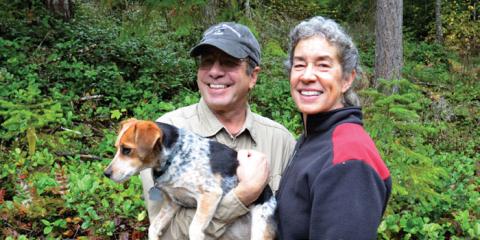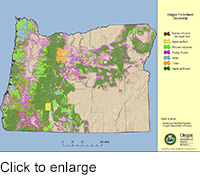Doubling down on family forest landowners
August 27, 2013
The most underappreciated group of forest landowners in Oregon is families. At least, that’s my opinion. The green forests that fringe our valleys and cities, especially in western Oregon, are nearly all family forestland. (See the purple-shaded areas on the map below.) More than 60,000 families own forests between 10 acres and 5,000 acres. That acreage is the state’s definition for “family forestland,” although most own fewer than 100 acres.
Oregon’s family forests close to our cities and towns protect water quality and fisheries, and provide substantial amounts of prime wildlife habitat. And, unlike in other states where forestland is more easily developed into homes and strip malls, Oregon’s unique system of zoning and land-use laws protects forests and agricultural lands.Nearly 250,000 families own forests if you count large backyards of at least 2 acres of trees.
I’ve visited many of these family-owned parcels, and they are remarkable. Some people manage them almost like family parks; others manage them for spurts of timber income, generally timed to the needs of kids going to college or retirement. They are a place of refuge for those living on them – and the best ones are managed under a plan. Resources such as the Oregon Small Woodland Association and the Oregon Tree Farm System can help landowners get started.
There is a long heritage: Families own 15 percent of Oregon’s 30 million forested acres, and it is the lowest elevation, most productive forestland in the state. Many people can trace their ownership back to the Donation Land Claim Act of 1850 that brought settlers to the Oregon Territory. Interesting to me is that this pre-Civil-War legislation allowed settlers to get, at no cost, 320 acres of land; or married couples, 640 acres of land.
Today, women own more than 40 percent of family forestland, and they call the shots. Another interesting statistic is that the average age of a family forest landowner is 65. That means that a heckuva lot of this land will be changing hands fairly soon, and that is worrisome for both landowners and their families.
Fortunately for Oregon family forest landowners, there are tremendous resources that can help.
For instance, several years ago, OFRI teamed with state and federal resource agencies, inheritance experts andOregon State University to help build a program called “Ties to the Land,” now managed by the Austin Family Business Program within the OSU College of Business. It is a great place to get started if you are wondering how to manage generational succession. (Tip: Engaging the next generation is critical to building ties to the land.)
Just this year, OFRI has doubled down on its commitment to family forest landowners. In January, we teamed with many of the same state and federal resource agencies, known collectively as the Partnership for Forestry Education, to jointly launch a new website called KnowYourForest.org. Please cruise around this site to see how families can access resources of all kinds to help with their forestland.
Coming soon, OFRI will publish a new booklet called Establishing and Managing Forest Trees in Western Oregon. You can see a download of it now. This publication complements an earlier publication called Understanding Eastside Forests. You can also find a publication called the Family Forest Landowner Resource Guide, a new version of which will be published later this fall.
Many families cherish the wildlife on their lands, and this year OFRI has published a new booklet in its Wildlife in Managed Forests series, this one called Deer and Elk.
Other publications in the Wildlife in Managed Forests series include Northern Spotted Owl, Stream-Associated Amphibians and the capstone publication, Oregon Forests as Habitat. Together, these publications – along with workshops, tours and conferences – are designed to help Oregon family forest landowners understand the implications of forest-management decisions on wildlife.
If you are a family with forestland – and don’t have a plan – it is never too late to get started. If you are an urban dweller and wonder about the forests you see in the valley, take heart, for families just like yours are managing a lot of things you like about Oregon.
Dave Kvamme
Director of Communications

